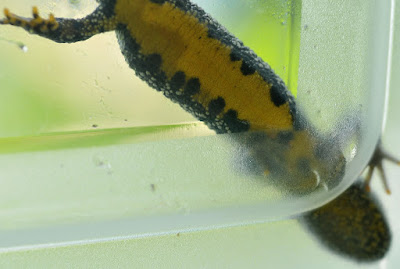Without doubt, the highlight was finding 3 great crested newts under several logs. These were photographed and put back under the log. A superb find and one that has been reported to Natural England and Herts and Essex Wildlife Trust. With this find come several important rules for Millennium Wood but it must be noted that they were discovered in an area where we carried out improvement work in the winter of 2015/16. At that time I wished to improve the quality of the grassland by removing many poor and failing trees. By removing these, it meant light and rain could penetrate through the gaps in the woodland canopy and permit grasses and wild flowers to prosper. This work was further enhanced by the placement of many small log piles, under which, we discovered the newts. With the nearest pond some 400 yards away, it is now imperative that we find time and money to scrape out the original pond within the wood, add a quality liner and allow it to fill naturally with rain water. Once certain pond vegetation is added, this could be a superb opportunity to increase the newt population. Newts, as amphibians, only return to ponds to breed. The rest of the time they remain under log piles, hunting by night in grassy areas. Just the habitat we have provided, so all present were very excited by this excellent discovery.
The only other highlight was the flushing of a field mouse that scurried over several pairs of feet before hiding itself away. Another good record as their presence will encourage creatures towards the top of the food chain to move in, such as falcons, owls, foxes etc.
Creatures identified so far from the 2 hour search:
Butterflies: (Lepidoptera)
- Speckled Wood
- Brimstone (male)
Micro Moths: (Lepidoptera)
- Nematopoon swammerdammella (longhorn moth species)
- Agonopterix arenella
Macro moths: (Lepidoptera. Note these were trapped overnight and released back into the habitat once seen by the children)
- Green carpet
- silver ground carpet
- Scorched carpet
- common swift
- nut tree tussock
- small white wave
 |
| Green carpet |
Flies:(Diptera)
- Tipula lunata (cranefly)
- Tipula maxima (cranefly)
- Greenbottle (Lucilia sericata)
- St Mark's Fly (Bibio marci)
- Dark edged bee fly (Bombylius major)
Bugs: (Hemiptera)
- Phytocoris tiliae
- Scolopostethus thomsonii
- Rhabdomiris striatellus
- Aphis urtica (Dark green nettle aphid)
- Common froghopper (Philaenus spumarius)
 |
| Nettle weevil |
Beetle: (Coleoptera)
- Violet ground beetle (Carabus violaceus)
- Stomis pumicatus
- Pterostichus elanarius
- Pterostichus nigrata
- Pterostichus madidus
- Pollen beetle (Meligethes aeneus)
- Green nettle weevil (Phyllobius pomaceus)
 |
| Violet ground beetle |
 |
| Pterostichus melanarius |
Crickets and Grasshopper: (Orthoptera)
- Common groundhopper (Tetrix undulata)
Earwigs: (Dermaptera)
- Common earwig (Forficula auricularia)
Centipedes and millipedes (Chilopoda)
- Millipede (Cylindrolulus caeruleocinctus)
- Common centipede (Lithobius forficatus)
Mammal: (Mammalia in this case Rodentia)
- Field mouse
Birds: (Aves)
- whitethroat
- chiffchaff
- blackcap
- robin
- blackbird
- collared dove
- blue tit
- great tit
 |
| Blackcap |
Amphibians :(Amphibia)
As can be seen, the children did a great job of finding and potting creatures. We also tapped trees where we found caterpillars, mainly small green jobs from oak. Very difficult to identify these to specific species at this stage of their development. Consequently, I have potted them with plenty of leaf material and shall await their emergence as moths in high summer.














































No comments:
Post a Comment